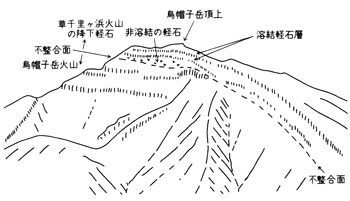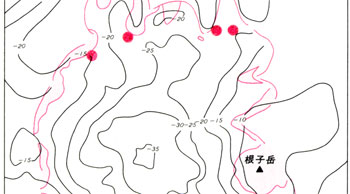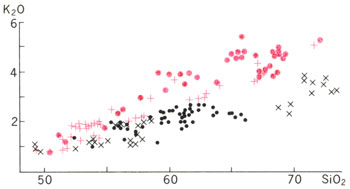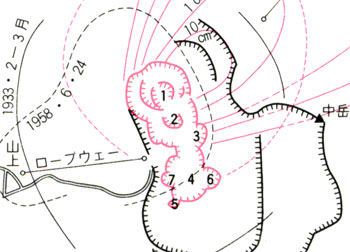Aso Volcano
Introduction / Topography of the caldera / Growth history of Aso volcano
Volcanoes within the caldera and their rocks
Nakadake
Rocks of Aso volcano / Hot springs and groundwater
Eruptive activities
Surveillance and observation of activities
References
![]() PREV
PREV ![]() NEXT
NEXT
Volcanoes within the caldera and their rocks Nakadake
Nakadake is a complex stratovolcano consisting of basaltic andesite and andesite. The summit ridge extending NS with steep cliff line in the east side of the active crater belongs to the east half of the major pyroclastic cone (of early volcanic body), the western half of which was lost and replaced by later and latest volcanic pyroclastic cones. The NS summit ridge changes its direction to the west at both ends connected to low ridges representing the old crater rim. The low lying area between the low ridge and the latest pyroclastic cone is called Sunasenrigahama.
Core of the early cone consists of stratified tuff and welded tuff breccia, and on the middle flank is seen thick unsolidified black stratified ash. Abundant lava flows are seen from the flank to the foot of the cone. Cliff to the east of Sunasenrigahama consists of thick pyroclastic formations intermittent with several unconformities. An area to the south of Sunasenrigahama is underlain by hydrothermally altered rocks with white, green, red, and other colors. Near here along the ridge trail, altered pyroclastic rocks are overlain by fresh pyroclastic rocks with an unconformity.
Latest pyroclastic cone including active crater is surrounded by late tuff cone, and to the NE of the No.1 crater rim the sequence is well exposed. This tuff cone consists of medium- to fine-grained stratified tuff. The origin of tuff is attributed to repeated surges from phreatomagmatic explosions which swept fine ejecta along the ground surface. Lava flows of this stage flowed down western side of old cone in NS direction.
The latest pyroclastic cones are a complex of cones surrounding NS aligned craters (![]() Fig. 5). They comprise tuffs (black and finely stratified), welded tuff breccia (especially near No. 4 crater), and explosion breccia (grayish white beds seen at the rims of No.2 and 3 craters), each of which corresponds to ash column type activity, Strombolian eruption with ejections of essential bombs, and phreatomagmatic explosion.
Fig. 5). They comprise tuffs (black and finely stratified), welded tuff breccia (especially near No. 4 crater), and explosion breccia (grayish white beds seen at the rims of No.2 and 3 craters), each of which corresponds to ash column type activity, Strombolian eruption with ejections of essential bombs, and phreatomagmatic explosion.
On the SE side of Nakadake cone is Maruyama parasitic volcano. Nakadake and Naraodake volcanoes are underlain by another volcano (Hakusui volcano) having totally different structure and rock types. Hakusui volcano is largely buried by the formers but exposed near the village of Hakusui and consists of dacite lava flow (obsidian and compact grey lava) with little pumice fall of the same rock type, and andesite lava. To the west of Nakadake and N and S on the cone, old andesite volcanic body probably independent from Nakadake is exposed. These are shown on the geologic map as small older volcanoes.
Takadake and Washigamine Takadake is the highest peak among the cluster of central volcanoes. It was formed on SW side of the peak top of slightly eroded Washigamine volcano. It is a small stratovolcano consisting of basalt and basaltic andesite. A crater of about 700 m wide in EW exists at the top. Near the top the rocks are mostly welded pyroclastics which overlie Washigamine volcano too, and lava and pyroclastic rocks are exposed on SE slope. Washigamine volcano is a dissected stratovolcano consisting of basalt and basaltic andesite with a group of sharp rocky peaks in NE of Takadake. Central area of Washigamine consists of welded pyroclastic and intrusive rocks surrounded by stratified coarse-grained pyroclastic rocks and little amount of thin lavas. On Sensui ridge extending to the north of Takadake is seen neatly stratified pyroclastic rocks which show a distribution with Washigamine (but not Takadake) as the center.
Naraodake This is somewhat dissected basaltic/basaltic andesitic stratovolcano with horse-shoe shaped crater opening to NE on the summit. The top is mainly of welded pyroclastic rocks while of stratified pyroclastic rocks and lava from midway and below of the peak. At the west side of the end of Sensuikyo tollway at about 900 m a.s.l. is exposed thick lava which is dacite lava belonging to Hakusui volcano which in turn is overlain by lava from Naraodake flowing down to the north.
Kishimadake, Ojodake, Kometsuka and Jano-o Those are basaltic volcanoes consisting of scoria cones near the tops and lavas flowed down to north/northeast ( Jano-o volcano is a scoria cone completely surrounded by lava flows from Kometsuka volcano and whether or not it was accompanied with lava is not known. ) Among those, Jano-o volcano is slightly older than the others, and other three were erupted in the order of Kishimadake, Ojodake, and Kometsuka. It seems that when scoria cones of Kishimadake and Ojodake were erupted, high eruption columns were formed: Two layers of scoria fall deposits are distributed beyond the east side of the caldera rim. Both of them offer good key beds. Between Kishimadake and Kometsuka volcanoes is a cluster of small scoria cones and vents called Kami-Kometsuka, the cross section of one of them can be seen along the Prefectural tollway.
Kusasenrigahama Kusasenrigahama is a large pumice hill with double craters of 500 m and 1 km diameters. The grassy plain of Kusasenrigahama is formed by burying an area between inner crater and western rim of outer crater with later ashes. The hills extending NS in the middle of grassy plain represent the western rim of the inner crater, and the southern end of the hills corresponds to remnant of destroyed lava dome. Main pumice hill was formed by large-scale pumiceous eruption and the pumice fall deposit overlies all the northern slopes including the top of Eboshidake ( ![]() Fig. 3 ). The pumices are found welded at two horizons ( this welded tuff is used for ornamental wall of the entrance hall of Volcanic Science Museum at Kusasenrigahama ) and in some flanks caused secondary flow movement. The pumice fall is characterized by orange yellow color, and along with AT volcanic ash lying above, distributed widely offering good key beds outside of the caldera especially in the south.
Fig. 3 ). The pumices are found welded at two horizons ( this welded tuff is used for ornamental wall of the entrance hall of Volcanic Science Museum at Kusasenrigahama ) and in some flanks caused secondary flow movement. The pumice fall is characterized by orange yellow color, and along with AT volcanic ash lying above, distributed widely offering good key beds outside of the caldera especially in the south.
Sawatsuno lava underlying pumice bed of Kusasenrigahama volcano is a black glassy dacite lava. It flowed down to the west on the slope north of Yunotani Hot Spring branching into two flows; one to the upstream of Sugarugataki, and another to Tochinoki Hot Spring. The vent is not determined but as the mineral and chemical compositions are similar to the pumice of Kusasenrigahama, both probably belong to the same source.
Eboshidake volcano is somewhat dissected andesitic stratovolcano situated to the south of Kusasenrigahama. The highest point of the Eboshidake is covered by Kusasenrigahama volcanic ejecta as mentioned before. Stratified rocks visible at the top belong to Kusasenrigahama volcano while lower part belongs to Eboshidake itself ( ![]() Fig. 2 ). The central part of the volcano consists of coarse-grained pyroclastic rocks and lava flow. The lava flowed down to the west, several flow units of which are exposed near Jigoku and Tarutama Hot Springs with its leading end reached to Takamori railway line of JR.
Fig. 2 ). The central part of the volcano consists of coarse-grained pyroclastic rocks and lava flow. The lava flowed down to the west, several flow units of which are exposed near Jigoku and Tarutama Hot Springs with its leading end reached to Takamori railway line of JR.
Okamadoyama This is somewhat dissected andesitic stratovolcano to the south of Eboshidake. At the top is a horse shoe shaped crater of 800 m wide in largest dimension opening to ENE. On its flanks are exposed continuous cliffs made of several lava flows.
Yomineyama The top of this volcano is situated to the south of Jigoku Hot Spring and a ridge convex to the south is visible on the steep hillside. The volcano consists of basaltic welded pyroclastic rocks. The volcano is southern half of pyroclastic hill with its northern half destroyed, the area of which was buried with later deposits. There is a small volcano SE of Yomineyama between Yomineyama below and Okamadoyama above and consisting of basaltic pyroclastic rocks and lava flows. We decided to call it here as Matsunoki volcano. North of Higashishimoda village at SW foot of Yomineyama is exposed an andesite lava flow belonging to a small volcanic body of earlier age.
Hontsuka, Haizuka, and Kitazuka Three small hills jutting out from the plain of Aso Valley NE of Uchinomaki Station of Hohi railway line of JR belong to a ruin of an independent volcano called Hontsuka volcano. The rock is hornblende dacite which is unique among the cluster of central volcanoes. At the base of each hill is exposed subaqueous porous lava with well developed joints. On the other hand, the tops of Hontsuka and Kitazuka consist of dense lavas formed on-land suggesting the level of water at the time between those and subaqueous lavas, and gives strong evidence that the Aso Valley was once filled with water.
Lavas at the western rim of the caldera Akamizu lava is pyroxene andesite lava flow exposed near Akamizu, and Yoshioka lava is basaltic lava near Yoshioka Village south of Yunotani Hot Spring. It is characterized by much olivine and large augite phenocrysts. Often it is dark green colored due to slight hydrothermal alteration. Akase lava is basaltic lava flow exposed on the riverbed of Kurokawa River from downstream of Akase to Sugarugataki Fall and from there continuously seen to Tateno station forming terrace-like topography on both sides of the river. It is slightly older than AT ash bed showing remarkable down erosion along Shirakawa Gorge since that time. Tateno lava is exposed as gorge walls along Kurokawa River from Sugarugataki Fall to Tateno. It is black colored fine-grained andesite lava with well developed columnar joints. Tochinoki lava is aphyric andesite lava with well developed platy joints and exposed at the cliff on the back of Tochinoki Hot Spring. To the north of Nagano along a road cutting in the east of Tochinoki, welded pyroclastic rock of identical rock type is exposed. Ayugaerinotaki lava is two basaltic lava sheets forming Ayugaerinotaki Fall of Shirakawa Gorge.
Deposits distributed on the mountain feet and plains Kugino Formation is distributed in the west part of Nango Valley forming flat surface of about 370 m a.s.l. It consists of horizontally bedded silt, sand, and ash and includes fresh-water diatom fossils. It is deposited from a lake existed at the time of eruptions of Tochinoki and Tateno lavas. Post-caldera deposits fills caldera bottom of Aso Valley forming flat surface. They are deposits from a lake which occupied the caldera. Fan deposits are distributed at the feet of volcanoes, and talus deposits are seen at the bottoms of steep cliffs. Caldera fill, fan deposits, and talus are transitional to each other and not necessarily clearly separated in the field. Along Shirakawa river west of Nango Valley is small scale river terrace covered with some deposits on top. Ash fall deposit is ubiquitous except for areas of steep slopes. It is thicker where the underlying formation is older, or more easterly the area is. On the geologic map the ash fall deposit is shown only when it is exceptionally thick and no underlying formation is exposed.
Aso caldera On the caldera wall are exposed pyroclastic flows, which led to the formation of the caldera, and volcanic rocks preceding Aso volcano. The latter shows larger distribution than the former. At the foot of the caldera wall, five holes with the depths ranging from 150 to 500 m were drilled down to Cretaceous basement granite and sedimentary rocks ( Nobuhiro Tanaka, pers. comm., 1985 ) suggesting that collapsed area of the basement is smaller than the outline of caldera ( ![]() Fig. 3 ).
Fig. 3 ).
Nekodake Except for the eastern foot area, the whole body of this volcano is distributed within the caldera, and because of this it has been identified as one of the central volcanoes. However, the volcano underlies Aso-3 pyroclastic rocks. Therefore, it does not belong to post-caldera volcanoes. It is an andesitic stratovolcano and the age is about 150,000 years before present. From either north or south sides, stratified structure of lavas and pyroclastic rocks sloping symmetrically from the center outward is clearly visible on deeply dissected radiating valleys. In both east and west sides are preserved original slopes. The peak top ridge is made of hard lava and serrated. The rocky top at the center, Tengudake, is a dike representing central vent from which several dikes radiate and form rocky planar ridges. The rocks of this volcano are basaltic andesite and andesite and sometimes accompanied with hornblende phenocrysts in addition to usual pyroxenes. Therefore, the rocks are different from those consisting of Aso volcano ( ![]() Fig. 4 ). From the gravity anomaly ( Bouguer anomaly ) data, positioning of the volcano on the caldera rim is reasonable too (
Fig. 4 ). From the gravity anomaly ( Bouguer anomaly ) data, positioning of the volcano on the caldera rim is reasonable too ( ![]() Fig. 3 ).
Fig. 3 ).



 ZOOM
ZOOM